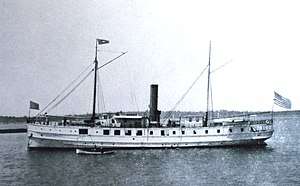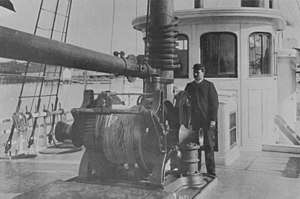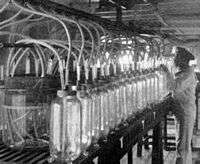USFC Fish Hawk
 Fish Hawk ca. 1900 | |
| History | |
|---|---|
| Name: | USFC Fish Hawk |
| Namesake: | Fish hawk, an alternative name for the osprey |
| Builder: | Pusey and Jones Company, Wilmington, Delaware |
| Completed: | 1880 |
| Commissioned: | Spring 1880 |
| Decommissioned: | January 1926 |
| Homeport: | Woods Hole, Massachusetts |
| General characteristics | |
| Type: | Floating fish hatchery and fisheries research ship |
| Displacement: | 484 tons |
| Length: | 157 ft (48 m) |
| Propulsion: | Steam, coal-fired, two screws |
| Sail plan: | Fore-and-aft two-masted schooner rig |
| Crew: | 84, plus up to 25 additional personnel on temporary assignment |

USFC Fish Hawk was a fisheries research ship operated by the United States Commission of Fish and Fisheries and its successor, the United States Bureau of Fisheries, from 1880 to 1926. She was the first large ship purpose-built by any country for the promotion of fisheries,[1] and spent her 46-year career operating along the United States East Coast, in the Gulf of Mexico, and off Puerto Rico.[1]
Design and construction
From its foundation in 1871, the U.S. Commission of Fish and Fisheries, more generally known as the U.S. Fish Commission, recognized a need for ships to operate along the coast of the United States to engage in exploration, conduct surveys, and perform scientific research on marine resources. In addition, fishery scientists of the time believed that successful spawning was the most significant factor in the productivity of fisheries; the spawning of American shad at the time was the most important fishery in the United States, and because shad runs lasted only a month in any given location, a floating fish hatchery that could move along the coast was deemed more cost-effective than constructing shad hatcheries along the entire U.S. East Coast.[1]
The United States Department of the Navy loaned the Fish Commission a small steam launch to conduct its field work during the summer of 1871. The Commission had no ship in 1872, but during each summer from 1873 through 1875 the Navy Department loaned it the 100-ton steamer Blue Light. The Commission again had no ship in 1876, but the Navy Department loaned it the 306-ton steamer Spedwell during the summers of 1877, 1878, and 1879. These vessels were only minimally modified for fisheries research work, with only primitive equipment installed. The Fish Commission clearly required a vessel designed specifically for service as a floating hatchery and fisheries research ship, and so in 1879 the United States Congress appropriated $45,000 (USD) for the construction of a fisheries research steamer to be named Fish Hawk.[1]

The Fish Commission chose a design by C. W. Copeland of the United States Lighthouse Board,[1] and the Pusey and Jones Company built the ship at Wilmington, Delaware.[2] Fish Hawk had a fore-and-aft two-masted schooner rig, coal-fired steam propulsion, and twin screws, and was intended for coastal work rather than oceanic research. She had an iron hull sheathed with about 3 inches (76.2 mm) of yellow pine, caulked and coppered. Above the main deck she was of wooden construction. The pilot house, captain's quarters, and a laboratory were on a promenade deck extending along the entire length and across the entire width of the ship.[1]
Fish Hawk's main deck was filled with hatching equipment to allow her to serve as a floating hatchery for American shad, striped bass, mackerel, and herring. A pump supplying 10,000 gallons (37,854 liters) of water per hour and two 500-gallon (1,893-liter) distribution tanks fed the equipment. Fertilized fish eggs were placed in 36 hatching cones, each capable of hatching 200,000 American shad eggs, and feed valves regulated the current through the cones to keep the eggs gently in motion so they would not mat or settle to the bottom. Fish Hawk also had 18 hatching cylinders – each capable of holding 250,000 eggs – with wire gauze bottoms; the cylinders were suspended from beams hanging over the sides of the ship and partially submerged, with nine on each side. Cam machinery caused the cylinders to rise gently and drop more rapidly for about eight inches (20 cm), which made the eggs circulate freely without settling on the bottom.[1]
Fish Hawk also was outfitted to conduct general scientific research related to fisheries, including depth sounding, measuring the temperature of the sea bottom, and collecting marine animals and plants. She had a hoisting winch with 1,000 fathoms (6,000 feet; 1,829 meters) of steel cable for trawling and dredging, an otter trawl, a 9-foot (2.75-meter) beam trawl, an 11-foot (3.6-meter) beam trawl, a 17-foot (5.2-meter) beam trawl, Blake and Chester rake dredges, and a tangle bar, the latter an iron axle and wheels with deck swabs or bundles of rope yarn on chains that Fish Hawk could drag along the sea bottom to capture marine animals and plants. For hydrography, she had a sounding machine with 600 fathoms (3,600 feet; 1,097 meters) of piano wire, deep-sea reversing thermometers, and density salinometers.[1]
Fish Hawk had a crew of 84 and berthing for another 25 people on temporary assignment to the ship, such as scientists, technicians, or passengers aboard as observers.[2]
Service history

The Fish Commission commissioned Fish Hawk in the spring of 1880 with a United States Navy crew commanded by Lieutenant Zera Luther Tanner. Her home port throughout her career was Woods Hole, Massachusetts.[1]
Fish Hawk's capabilities launched a new era in both fisheries research and fish culture. Her first assignment was to investigate a previously unknown fish, the tilefish, which a commercial fisherman had brought to the Fish Commission station in Gloucester, Massachusetts, in 1879. During 1880, operating out of Newport, Rhode Island, she made four voyages to dredge the edge of the continental shelf, during which she gathered data establishing the range and quantity of the tilefish, which later would become an important fishery. Such were her scientific capabilities that she also discovered 40 new species of mollusk and 20 new species of fishes during the four voyages.[1] With the four voyages completed, she returned to Wilmington to have her hatching cones installed so that she could begin her first hatchery work with shad eggs off the southeast coast of the United States by about March 1881.[2]
Fish Hawk was designed to work year-round in an annual cycle in which she engaged in scientific research involving trawling and dredging in the summer, then steamed north to collect and hatch cod eggs in late autumn. With the arrival of winter, she steamed south to hatch shad eggs, moving to various points along the coast during the winter and spring in accordance with the natural timing of shad runs. With those completed, she renewed the cycle by returning to research work during the following summer. As fisheries researchers later came to understand the reproduction of Spanish mackerel and striped bass, Fish Hawk added hatching of these species to her annual routine.[2]
Fish Hawk went on to serve the Fish Commission and its successor, the United States Bureau of Fisheries, for nearly 46 years, trawling and dredging to discover and investigate new fishery resources and to collect marine animals and plants to gather information about their identity and life history. She worked on the continental shelf along the entire U.S. East Coast from Maine to Florida, as well as in the Gulf of Mexico and off Puerto Rico.[1] In December 1916, Fish Hawk participated in the eighth annual Convention of the Southern Commercial Congress in Norfolk, Virginia, joining the Bureau of Fisheries steamer Roosevelt in exhibiting several fishery-related items and devices.[3]
Fish Hawk made her last two cruises between October and December 1925, and the U.S. Bureau of Fisheries decommissioned her in January 1926.[1][4] The Bureau replaced her that year with the fisheries research ship Albatross II.[5]
References
- 1 2 3 4 5 6 7 8 9 10 11 12 NOAA History: R/V Fish Hawk 1880-1926
- 1 2 3 4 Anonymous "Out With the Fish-Hawk," The New York Times, September 20, 1880
- ↑ afsc.noaa.gov AFSC Historical Corner: Roosevelt, Bureau's First Pribilof Tender Retrieved September 15, 2018
- ↑ Galtsoff, Paul S., The Story of the Bureau of Commercial Fisheries Biological Laboratory Woods Hole, Massachusetts, Washington, D.C.: United States Department of the Interior, 1962, p. 40.
- ↑ NOAA History: Albatross II